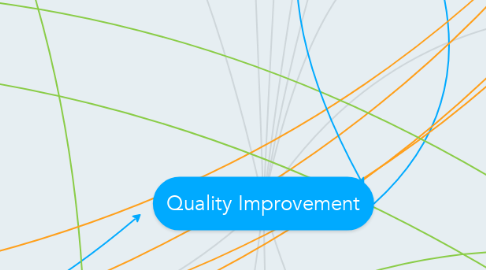
1. Why? -->
1.1. New challenges
1.1.1. more specialized care
1.1.2. more chronic diseases
1.1.3. better informed patients
1.1.4. veranderde rol van de arts
1.1.5. more complicated procedures
1.2. Making high quality care still available
1.3. Ethical and cultural differences still exsist
1.4. We ask our patients to improve all the time
2. IOM report: improvement of care focus on:
2.1. Safe: Avoid injuries to patients from the care that is intended to help them.
2.2. Timely: Reduce waits and sometimes harmful delays for patients and providers
2.3. Effective: Provide the appropriate level of services based on scientific knowledge.
2.4. Efficient: Avoid waste, including waste of equipment, supplies, ideas, and energy.
2.5. Equitable: Care shouldn't vary in quality because of personal characteristics.
2.6. Patient-centred: Provide care that is respectful of and responsive to individual patients.
3. Science
3.1. Change the perfectly designed system
3.2. Sheward and Deming: applied science
3.2.1. People have to apply it
3.2.1.1. d
3.2.1.1.1. d
3.2.2. System of Profound Knowledge
3.2.2.1. Apprectiation of a system
3.2.2.2. Understanding variation
3.2.2.3. Theory of knowledge: develop, apply and test
3.2.2.4. Psychology of human behaviour
3.2.2.4.1. Change can be overwhelming
4. How to change a system?
4.1. Agility and small incremental steps
4.2. Builds on the ideas of others
4.3. Engage our own curiosity and see what motivates and inhibits the individual system path to change.
4.4. Kwaliteitscyclus
4.4.1. Fase 1: definiëring kwaliteit
4.4.2. Fase 2: diagnostiek: waarom is de zorg niet zoals gewenst?
4.4.3. Fase 3: behandeling: verbetering kwaliteit
4.4.3.1. Microniveau
4.4.3.1.1. Individu
4.4.3.2. Mesoniveau
4.4.3.2.1. Instelling
4.4.3.2.2. Afdeling/praktijk
4.4.3.3. Macroniveau
4.4.3.3.1. Nationaal
4.5. Zorgverleners zelf
4.5.1. kwalitatief hoogstaande zorg
4.5.1.1. nieuwe competenties
4.5.1.1.1. reflecteren op eigen handelen
4.5.1.1.2. verantwoording afleggen
5. Institute for Healthcare Improvement
5.1. Will
5.2. Ideas
5.3. Execution
5.3.1. Lean
5.3.2. Six Sigma
5.3.3. Model for Improvement
5.3.3.1. Set an aim
5.3.3.1.1. What are we trying to accomplisch?
5.3.3.1.2. Important issue
5.3.3.1.3. Small, short term
5.3.3.1.4. How good? By when? For whom?
5.3.3.2. Establisch measures
5.3.3.2.1. How will we know a change is an improvement?
5.3.3.2.2. Adapt, adopt or discard the changes
5.3.3.2.3. Family of measures
5.3.3.2.4. Run chart
5.3.3.3. Identify changes
5.3.3.3.1. Develop changes
5.3.3.3.2. Changes concepts
5.3.3.4. Test changes
5.3.3.4.1. PDSA cycles
5.3.3.4.2. Real time feedback, resultaatfeedback
5.3.3.5. Implement changes
5.3.3.5.1. Make the change a permanent part of how the process is done
5.3.3.6. Extent changes to other divisions or hospitals
6. Evidence Based Medicine
6.1. Doing the right things
6.1.1. Formulate clinical question
6.1.2. Search for the best evidence
6.1.3. Critically appraise
6.1.4. Apply to the systems
7. Doing things right
8. Curiosity
8.1. Asking questions
8.2. Always trying the next thing
8.3. Small steps
8.4. Act like children
9. Optimale zorg
9.1. Effectief
9.2. Doelmatig
9.3. Patiëntgericht
9.4. Veilig
9.5. Moreel verantwoord
10. Nederland
10.1. 40% te veel, te weinig of verkeerde zorg bij patiënten
10.2. 1/10 van de opgenomen patiënten loopt schade op, helft hiervan is te voorkomen
10.3. Verbeterpunten
10.3.1. Zorginhoud: geen over of onderdiagnostiek/behandeling
10.3.2. Zorgorganisatie: voldoende personeel, kosteneffectief
